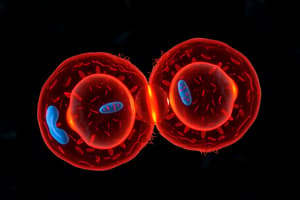Podcast
Questions and Answers
What process do spermatogonia undergo to produce primary spermatocytes?
What process do spermatogonia undergo to produce primary spermatocytes?
- Spermiogenesis
- Meiosis
- Mitosis (correct)
- Differentiation
During which phase do primary spermatocytes begin meiosis?
During which phase do primary spermatocytes begin meiosis?
- Spermiogenesis
- Meiosis II
- Meiosis I (correct)
- Mitosis
What is the result of the secondary spermatocytes undergoing Meiosis II?
What is the result of the secondary spermatocytes undergoing Meiosis II?
- Four spermatids (correct)
- Two secondary oocytes
- One oocyte and one polar body
- Two polar bodies
What occurs during spermiogenesis?
What occurs during spermiogenesis?
What is true about the primary oocyte's progress towards meiosis?
What is true about the primary oocyte's progress towards meiosis?
What is produced as a byproduct when a primary oocyte undergoes uneven cytokinesis during Meiosis I?
What is produced as a byproduct when a primary oocyte undergoes uneven cytokinesis during Meiosis I?
What structure in sperm cells is responsible for energy production?
What structure in sperm cells is responsible for energy production?
Which of the following statements about oogenesis is accurate?
Which of the following statements about oogenesis is accurate?
Which of these is a characteristic of Meiosis I?
Which of these is a characteristic of Meiosis I?
What is the main difference between somatic cells and germ cells?
What is the main difference between somatic cells and germ cells?
How does crossing over contribute to genetic diversity?
How does crossing over contribute to genetic diversity?
Which of the following is NOT a characteristic of spermatogenesis?
Which of the following is NOT a characteristic of spermatogenesis?
What is the significance of fertilization in the process of reproduction?
What is the significance of fertilization in the process of reproduction?
Which of the following is TRUE about the process of oogenesis?
Which of the following is TRUE about the process of oogenesis?
What is the role of independent assortment in generating genetic diversity?
What is the role of independent assortment in generating genetic diversity?
What is unique about the process of meiosis that contributes to the genetic diversity of offspring?
What is unique about the process of meiosis that contributes to the genetic diversity of offspring?
Flashcards
Spermatogonia
Spermatogonia
Diploid stem cells that undergo mitosis, some becoming primary spermatocytes.
Primary Spermatocytes
Primary Spermatocytes
Diploid cells that begin Meiosis I, leading to secondary spermatocytes.
Secondary Spermatocytes
Secondary Spermatocytes
Haploid cells resulting from Meiosis I that undergo Meiosis II.
Spermatids
Spermatids
Signup and view all the flashcards
Spermiogenesis
Spermiogenesis
Signup and view all the flashcards
Spermiation
Spermiation
Signup and view all the flashcards
Oogonia
Oogonia
Signup and view all the flashcards
Primary Oocyte
Primary Oocyte
Signup and view all the flashcards
Oogenesis
Oogenesis
Signup and view all the flashcards
Mitosis
Mitosis
Signup and view all the flashcards
Meiosis
Meiosis
Signup and view all the flashcards
Independent Assortment
Independent Assortment
Signup and view all the flashcards
Crossing Over
Crossing Over
Signup and view all the flashcards
Germ Cells
Germ Cells
Signup and view all the flashcards
Fertilization
Fertilization
Signup and view all the flashcards
Study Notes
Reproductive System: Gametogenesis
- Gametogenesis encompasses spermatogenesis (male gamete production) and oogenesis (female gamete production)
- Spermatogenesis occurs continuously in males, while oogenesis is cyclical in females, pausing until puberty
- Spermatogenesis results in four haploid sperm cells, whereas oogenesis yields one mature ovum and two or three polar bodies
- Timing and quantity of gamete production, as well as endocrine regulation, differ significantly between sexes
Mitosis and Meiosis
- Mitosis is cell division that produces two genetically identical daughter cells with the same chromosome number (diploid). It maintains chromosome count.
- Meiosis is a two-stage cell division process that reduces the chromosome number from diploid to haploid. This is crucial for sexual reproduction.
Cell Division by Mitosis
- Chromosomes replicate, forming sister chromatids.
- Chromosomes divide evenly, resulting in two daughter cells identical to the original cell (diploid).
Cell Division by Meiosis
- Meiosis is a two-stage process (Meiosis I and Meiosis II).
- Meiosis I: Replication, homologous chromosome pairs separate reducing the chromosome number to haploid
- Meiosis II: Sister chromatids separate, producing four haploid gametes
Meiosis Produces New Combinations of Genes
- Independent assortment: During Metaphase I, maternal and paternal homologous chromosomes randomly align, generating diverse combinations of chromosomes in gametes
- Crossing over: In Prophase I, homologous chromosomes exchange segments, creating new combinations of genes on each chromosome.
Gametogenesis and Fertilization
- Gametogenesis refers to the production of gametes (sperm and egg).
- Fertilization is the fusion of male and female gametes, combining their genetic material to create a zygote.
Spermatogenesis (Male Gamete Production)
- Spermatogonia (stem cells): Continuously divide by mitosis.
- Primary spermatocytes (diploid cells): Undergo Meiosis I, resulting in secondary spermatocytes
- Secondary spermatocytes (haploid cells): Undergo Meiosis II, producing spermatids
- Spermatids (haploid cells): Mature into sperm through spermiogenesis
- Spermiogenesis: Differentiation of spermatids into functional sperm cells (including acrosome formation)
Spermiogenesis
- Acrosomal vesicle formation
- Flagellum production
- Mitochondria gathering around flagellum to provide energy
Spermatozoa Anatomy
- Head: Nucleus and acrosome
- Mid-piece: Mitochondria
- Tail: Whip-like flagellum
Oogenesis (Female Gamete Production)
- Oogonia (stem cells): Divide by mitosis before birth.
- Primary oocytes: Enter Meiosis I but arrest until puberty.
- Secondary oocyte: Result of Meiosis I, arrested at Meiosis II, released monthly.
- Ovum (egg): Meiosis II completion occurs only if fertilization is successful.
- Uneven cytoplasmic division results in one mature ovum one polar body/two to three
- Oogenesis occurs in the ovaries; each month, some primary oocytes complete meiosis I, forming a secondary oocyte and polar body.
Spermatogenesis vs. Oogenesis
- Location: Testes vs. Ovaries
- Gamete Production: 4 sperm vs. 1 ovum and 2-3 polar bodies
- Gamete Size: Small sperm vs. large ovum
- Release: Continuous vs. cyclical
- Onset: Puberty vs. prenatal
- Duration: Lifelong vs. terminates with menopause
Studying That Suits You
Use AI to generate personalized quizzes and flashcards to suit your learning preferences.




